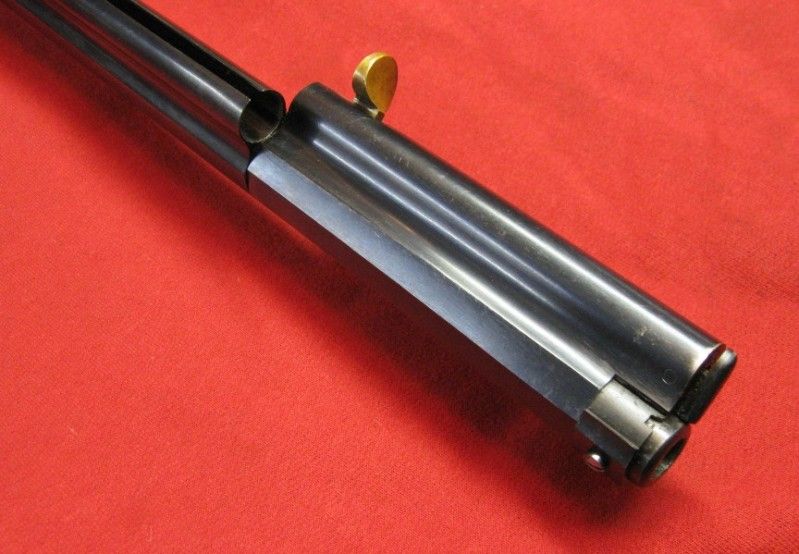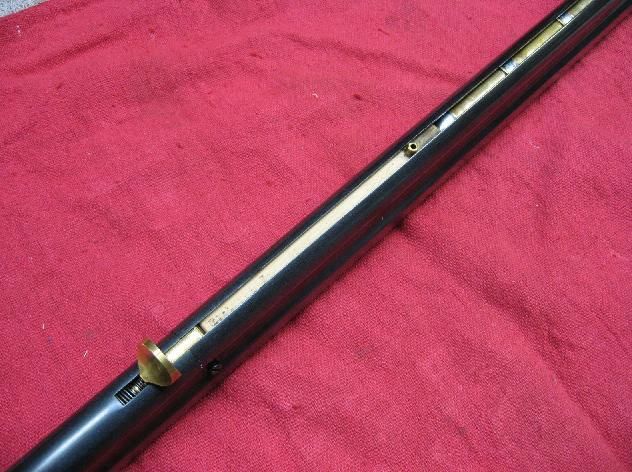Pretty sure the Spencer had a wooden forearm.
Sorry, I was talking specifically about the Henry - Winchester line of lever guns.
The Henry rifle did not spring full blown from the mind of B. T. Henry. It was an evolutionary advancement on the work of Daniel Wesson and Horace Smith who developed the Volcanic repeater, which was in turn a further development of the work of Hunt and Jennings.
Yes, there were a few Henry rifles made with iron frames. The estimates are somewhere between 200 and 400. Nobody knows exactly how many. In 1860 Oliver Winchester was having trouble getting investors to line up to sink money into the venture. With the outbreak of the Civil War in April of 1861 it suddenly became obvious that producing high quality repeating rifles would be a good investment. Winchester ordered top of the line equipment to produce the rifles, but some of the equipment took 15 months before it was ready. In the meantime, there is evidence that Winchester tried to speed up things by contracting out iron frames and butt plates to the Arcade Malleable Iron Company of Worcester Mass. There is even speculation that Colt may have produced some iron parts for the Henry rifle while Winchester was attempting to bring the new factory in New Haven up to speed. This information comes from The Historic Henry Rifle by Wiley Sword.
Here is a link to an Iron Framed Henry that was up for auction a few years ago. It includes good photos of the gun.
http://www.rockislandauction.com/viewitem/aid/51/lid/1492
Later in production, once all the equipment in the factory was operating, all of the subsequent Henry rifles had the bronze, gunmetal frames I spoke of earlier. Although the Henry patents go back to 1860, production did not really get going until 1862. Production of the Henry rifle ceased in 1866 after only about 14,000 had been made.
To understand the advancement the side loading gate represented, one has to understand how awkward it was to load the Henry. Here are a few photos of my Uberti replica 1860 Henry.
This is the muzzle in the closed position.
This is how the gun was loaded. The brass follower has been completely pulled up the length of the magazine. The magazine spring is completely compressed in the shroud surrounding the barrel. The brass piece is the follower, specifically it is the tab of the follower that rides in the slot at the bottom of the magazine. Once the follower had been drawn the length of the magazine, the false muzzle was rotated to expose the end of the magazine. The end of the magazine is visible, notice the slot. The magazine of the Henry rifle was not a separate tube as with all the subsequent Winchesters, it was an integral part of the barrel, with the tube formed over a mandrel.

In this photo, cartridges have been loaded into the magazine and the false muzzle has been rotated to the closed position. Several cartridges are visible through the slot. Ignore the wooden spacer stick, that is a modern crutch. You can see a bit of the magazine spring in front of the follower tab, it is completely compressed at this point.
This photo shows follower tab protruding through the slot at the bottom of the magazine. The tab slid back the length of one cartridge every time the action was manipulated. It was necessary to have this arrangement in order to compress the spring and get the follower out of the way for loading from the front.
There were several disadvantages to the design.
The open slot allowed dirt and mud into the magazine, which could bind up the gun.
If the shooter accidentally blocked the follower tab with his hand while firing the rifle, it stopped feeding fresh rounds into the action.
Because of the slot arrangement, a wooden forend was not practical. The bare steel got very hot in the summer when fired with Black Powder ammunition.
Towards the end of Henry production, a few experimental models were made using the side loading gate. These were prototypes only, and never made it to production. A few years ago Uberti offered a few replicas of these for sale, they were marketed as 'transitional' Henry rifles.
In 1866 Oliver Winchester and B. T. Henry had a falling out over money. While Winchester was on vacation in Europe, Henry tried an end run around him and tried to take over the company, petitioning the Connecticut legislature to change the name to the Henry Repeating Arms Company. Oliver Winchester got wind of it in Europe and cut his vacation short, putting an end to Henry's attempt. Winchester then changed the name of the company to the Winchester Repeating Arms Company.
In 1866 the first true Winchester was introduced. It was sometimes called the Improved Henry. It incorporated the Kings Patent loading gate. The magazine was made from a separate tube, hanging below the barrel. This simplified the manufacturing process. Because the protruding tab of the follower was no longer needed, a wooden forend was fitted, solving the problem of dirt in the magazine and isolating the shooter's hand from the hot barrel. This model did not become known as the Model 1866 until 1873 when the Model 1873 was introduced. Previous to that it was simply known as the Winchester, or the Improved Henry. The Model 1866 was always made with a bronze gunmetal frame, there were never any made with an iron or steel frame. The Model 1866 fired the same anemic 44 caliber Henry Rimfire ammo that the Henry rifle had fired. Towards the end of production, a few 1866s were made up chambered for a centerfire version of the 44 Henry cartridge. It still had the same 28 or so grains of FFg in the case as the rimfire cartridge did. These centerfire 1866s were mostly sent to South America.
The first true centerfire Winchester did not appear until 1873, with the Model 1873, chambered for the brand new 44 WCF (44-40) centerfire cartridge. The 44-40 was a more powerful cartridge, holding 40 grains of powder, and because of this the first 1873 rifles had iron frames, later steel. The Model 1866 was produced concurrently with the Model 1873 up until 1898. It was the last rifle Winchester ever produced with a bronze, gunmetal frame.




